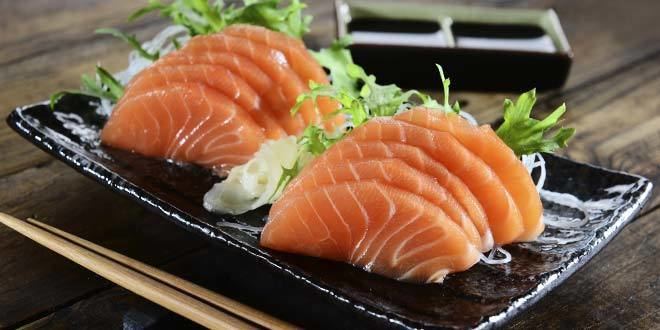 | ||
Similar | ||
Sashimi street food in japan
Sashimi (/səˈʃiːmiː/; Japanese: 刺身, [saɕi̥mi]) is a Japanese delicacy consisting of very fresh raw meat or fish sliced into thin pieces.
Contents
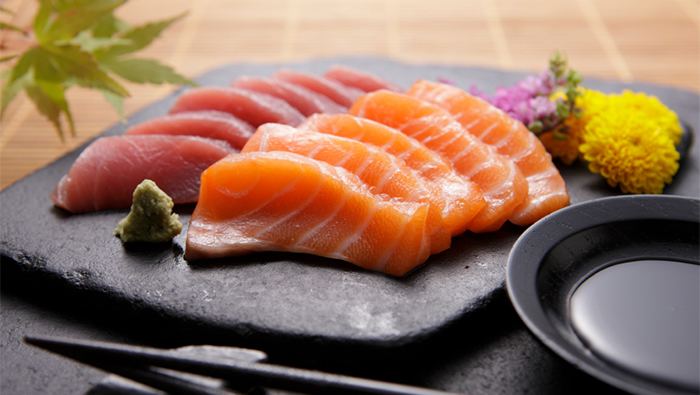
Origin
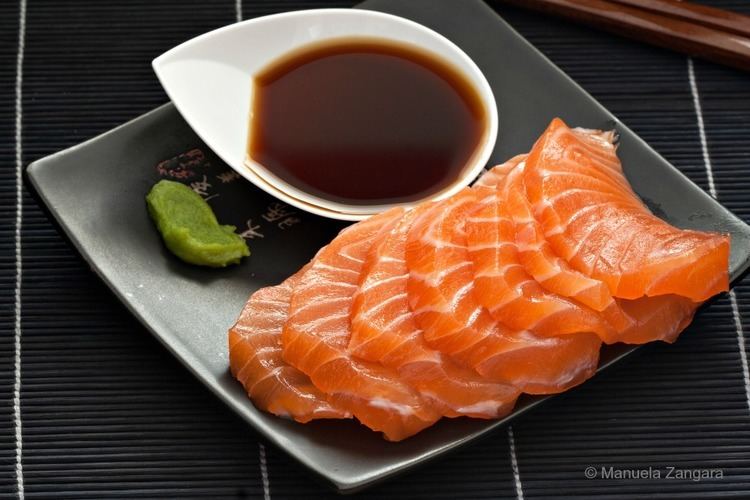
The word sashimi means "pierced body", i.e. "刺身" = sashimi, where 刺し = sashi (pierced, stuck) and 身 = mi (body, meat). This word dates from the Muromachi period, and was possibly coined when the word "切る" = kiru (cut), the culinary step, was considered too inauspicious to be used by anyone other than samurai. This word may derive from the culinary practice of sticking the fish's tail and fin to the slices in identifying the fish being eaten.
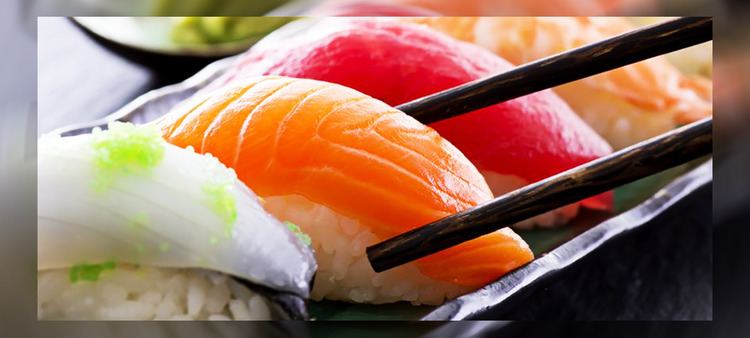
Another possibility for the name could come from the traditional method of harvesting. "Sashimi-grade" fish is caught by individual handline. As soon as the fish is landed, its brain is pierced with a sharp spike, and it is placed in slurried ice. This spiking is called the ike jime process, and the instantaneous death means that the fish's flesh contains a minimal amount of lactic acid. This means that the fish will keep fresh on ice for about ten days, without turning white or otherwise degrading.
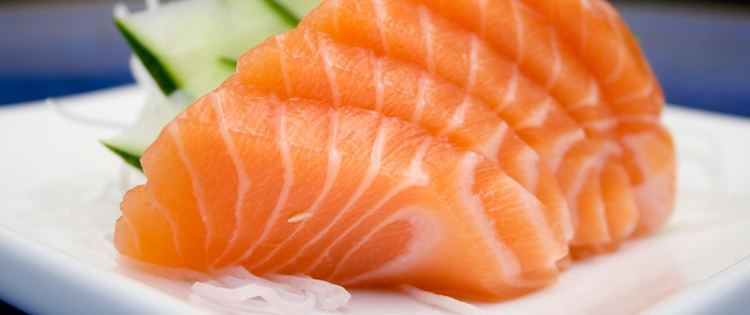
Many non-Japanese use the terms sashimi and sushi interchangeably, but the two dishes are distinct and separate. Sushi refers to any dish made with vinegared rice. While raw fish is one traditional sushi ingredient, many sushi dishes contain seafood that has been cooked, and others have no seafood at all.
Serving
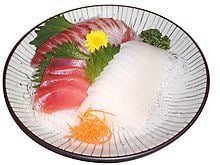
Sashimi is often the first course in a formal Japanese meal, but it can also be the main course, presented with rice and miso soup in separate bowls. Japanese chefs consider sashimi the finest dish in Japanese formal dining and recommend that it be eaten before other strong flavors affect the palate.

The sliced seafood that composes the main ingredient is typically draped over a garnish. The typical garnish is Asian white radish, daikon, shredded into long thin strands, or single leaves of the shiso (perilla) herb.
Sashimi is popularly served with a dipping sauce (soy sauce) and condiments such as with wasabi paste and grated fresh ginger, or, for meat sashimi, ponzu, and such garnishes as shiso and shredded daikon radish. Wasabi paste is sometimes mixed directly into soy sauce as a dipping sauce, which is generally not done when eating sushi. Another way to flavor soy sauce with wasabi is to place the wasabi mound into the soy sauce dish and then pour it in. This allows the wasabi to infuse the soy sauce more subtly. A reputed motivation for serving wasabi with sashimi (and also gari, pickled ginger), besides its flavor, is killing harmful bacteria and parasites that could be present in raw seafood. Other garnishes, more common in Japan than overseas, include red water pepper sprouts beni-tade (紅蓼) and a small chrysanthemum kogiku (小菊). The chrysanthemum, unlike other garnishes, is not intended to be eaten, and in cheap service (such as at supermarkets) may be substituted with a plastic flower.
Preparation
In order to highlight the fish's appearance, the chef cuts it into different thicknesses. The hira-zukuri cut, which translates into "rectangular slice", is the standard cut for most sashimi. Typically this style of cut is the size of a domino and 10 mm (3⁄8 in) thick. tuna, salmon, and kingfish are most commonly cut in this style. The uzu-zukuri cut, which translates to "thin slice", is an extremely thin, diagonally cut slice that is mostly used to cut firm fish, such as bream, whiting, and flounder. The dimensions of this fish is usually 50 mm (2 in) long and 2 mm (1⁄16 in) wide. The kaku-zukuri cut, which translates to "square slice", is the style in which sashimi is cut into small, thick cubes that are 20 mm (3⁄4 in) on each side. The ito-zukuri cut, which translates into "thread slice," is the style in which the fish is cut into thin sheets, less than 2 mm (1⁄16 in) thick. The fish typically cut with the ito-zukuri style include garfish and Squid.
Varieties
The most popular main ingredients for sashimi includes:
Some sashimi ingredients, such as octopus, are sometimes served cooked given its chewy nature. Most seafood, such as tuna, salmon, and squid, are served raw.
Tataki (たたき or 叩き, "pounded") is a type of sashimi. It is quickly and lightly seared on the outside, leaving it raw inside.
Less common, but not unusual, sashimi ingredients are vegetarian items, such as yuba (bean curd skin), and raw red meats, such as beef (known as gyuunotataki) or horse (known as basashi). chicken "sashimi" (known as toriwasa) is considered by some to be a delicacy; the Nagoya kōchin, French poulet de Bresse and its American derivative, the blue foot chicken, are favored by many for this purpose, as, besides their taste, they are certified to be free of Salmonella. Chicken sashimi is sometimes slightly braised on the outside.
Safety
As a raw food, sashimi can result in foodborne illness when bacteria or parasites are present; for example, anisakiasis, is a disease caused by the accidental ingestion of larval nematodes in the family Anisakidae, primarily Anisakis simplex but also Pseudoterranova decipiens. In addition, incorrectly prepared Fugu fish may contain tetrodotoxin, a potent neurotoxin.
Another type of food borne illness that could occur after consuming tainted sashimi is Diphyllobothriasis. This disease is an infection within the intestines that occurs when the tapeworm Diphyllobothrium latum is consumed. Common fish such as trout, salmon, pike, and sea bass harbor this parasitic larvae in their muscles. Due to the new innovation of the chilled transport system paired with the salmon and trout consumption, an increasing number of cases have been recorded annually in northern Japan due to the spread of this disease.
Traditionally, fish that spend at least part of their lives in brackish or fresh water were considered unsuitable for sashimi because of the possibility of parasites. For example, salmon, an anadromous fish, is not traditionally eaten straight out of the river. A study in Seattle, Washington, showed that all wild salmon had roundworm larvae capable of infecting people, while farm-raised salmon did not have any roundworm larvae.
Freezing is often used to kill parasites. According to European Union regulations, freezing fish at −20 °C (−4 °F) for 24 hours kills parasites. The U.S. Food and Drug Administration (FDA) recommends freezing at −35 °C (−31 °F) for 15 hours, or at −20 °C (−4 °F) for 7 days.
While Canada does not federally regulate freezing fish, British Columbia and Alberta voluntarily adhere to guidelines similar to the FDA's. Ontario attempted to legislate freezing as part of raw food handling requirements, though this was soon withdrawn due to protests by the industry that the subtle flavors and texture of raw fish would be destroyed by freezing. Instead, Ontario has decided to consider regulations on how raw fish must be handled prior to serving.
Some fish for sashimi are treated with carbon monoxide to keep the flesh red for a longer time in storage. This practice can make spoiled fish appear fresh.
Environmental concerns
The increased popularity of bluefin tuna for sashimi is reported to have brought this popular species to the verge of extinction. Farming bluefin does not help the situation, because the captive fish are not raised from spawn, but rather from small wild fish that are netted and transported to the farms, mostly in the Mediterranean. However, Japanese scientists may have found a way to save wild bluefin tuna from extinction by successfully breeding and raising the fish in captivity for the first time.
